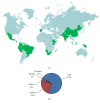Medicinal Plants for the Treatment of Local Tissue Damage Induced by Snake Venoms: An Overview from Traditional Use to Pharmacological Evidence
- PMID: 28904556
- PMCID: PMC5585606
- DOI: 10.1155/2017/5748256
Medicinal Plants for the Treatment of Local Tissue Damage Induced by Snake Venoms: An Overview from Traditional Use to Pharmacological Evidence
Abstract
Snakebites are a serious problem in public health due to their high morbimortality. Most of snake venoms produce intense local tissue damage, which could lead to temporary or permanent disability in victims. The available specific treatment is the antivenom serum therapy, whose effectiveness is reduced against these effects. Thus, the search for complementary alternatives for snakebite treatment is relevant. There are several reports of the popular use of medicinal plants against snakebites worldwide. In recent years, many studies have been published giving pharmacological evidence of benefits of several vegetal species against local effects induced by a broad range of snake venoms, including inhibitory potential against hyaluronidase, phospholipase, proteolytic, hemorrhagic, myotoxic, and edematogenic activities. In this context, this review aimed to provide an updated overview of medicinal plants used popularly as antiophidic agents and discuss the main species with pharmacological studies supporting the uses, with emphasis on plants inhibiting local effects of snake envenomation. The present review provides an updated scenario and insights into future research aiming at validation of medicinal plants as antiophidic agents and strengthens the potentiality of ethnopharmacology as a tool for design of potent inhibitors and/or development of herbal medicines against venom toxins, especially local tissue damage.
Figures



Similar articles
-
Inhibition of local effects induced by Bothrops erythromelas snake venom: Assessment of the effectiveness of Brazilian polyvalent bothropic antivenom and aqueous leaf extract of Jatropha gossypiifolia.Toxicon. 2017 Jan;125:74-83. doi: 10.1016/j.toxicon.2016.11.260. Epub 2016 Nov 25. Toxicon. 2017. PMID: 27890774
-
Pharmacological re-assessment of traditional medicinal plants-derived inhibitors as antidotes against snakebite envenoming: A critical review.J Ethnopharmacol. 2022 Jun 28;292:115208. doi: 10.1016/j.jep.2022.115208. Epub 2022 Mar 18. J Ethnopharmacol. 2022. PMID: 35314419 Review.
-
Counteraction of Bothrops snake venoms by Combretum leprosum root extract and arjunolic acid.J Ethnopharmacol. 2014 Aug 8;155(1):552-62. doi: 10.1016/j.jep.2014.05.056. Epub 2014 Jun 18. J Ethnopharmacol. 2014. PMID: 24952279
-
The potential of Brazilian native plant species used in the therapy for snakebites: A literature review.Toxicon. 2022 Oct 15;217:17-40. doi: 10.1016/j.toxicon.2022.08.002. Epub 2022 Aug 8. Toxicon. 2022. PMID: 35952835 Review.
-
A novel synthetic quinolinone inhibitor presents proteolytic and hemorrhagic inhibitory activities against snake venom metalloproteases.Biochimie. 2016 Feb;121:179-88. doi: 10.1016/j.biochi.2015.11.031. Epub 2015 Dec 14. Biochimie. 2016. PMID: 26700145
Cited by
-
Anti-snake venom and methanolic extract of Andrographis paniculata: a multipronged strategy to neutralize Naja naja venom acetylcholinesterase and hyaluronidase.3 Biotech. 2020 Nov;10(11):476. doi: 10.1007/s13205-020-02462-4. Epub 2020 Oct 15. 3 Biotech. 2020. PMID: 33083200 Free PMC article.
-
Ethnobotanical Study of Indigenous Medicinal Plants of Jazan Region, Saudi Arabia.Evid Based Complement Alternat Med. 2019 Jun 2;2019:3190670. doi: 10.1155/2019/3190670. eCollection 2019. Evid Based Complement Alternat Med. 2019. PMID: 31275409 Free PMC article.
-
Community members and healthcare workers' priorities for the control and prevention of snakebite envenoming in Ghana.PLoS Negl Trop Dis. 2023 Jul 21;17(7):e0011504. doi: 10.1371/journal.pntd.0011504. eCollection 2023 Jul. PLoS Negl Trop Dis. 2023. PMID: 37478151 Free PMC article.
-
Pharmacological Significance of Boraginaceae with Special Insights into Shikonin and Its Potential in the Food Industry.Foods. 2024 Apr 27;13(9):1350. doi: 10.3390/foods13091350. Foods. 2024. PMID: 38731721 Free PMC article. Review.
-
Quantitative Characterization of the Hemorrhagic, Necrotic, Coagulation-Altering Properties and Edema-Forming Effects of Zebra Snake (Naja nigricincta nigricincta) Venom.J Toxicol. 2018 Oct 24;2018:6940798. doi: 10.1155/2018/6940798. eCollection 2018. J Toxicol. 2018. PMID: 30473709 Free PMC article.
References
-
- Warrell D. A. Venomous animals. Medicine. 2012;40(3):159–163. doi: 10.1016/j.mpmed.2011.12.001. - DOI
Publication types
LinkOut - more resources
Full Text Sources
Other Literature Sources

